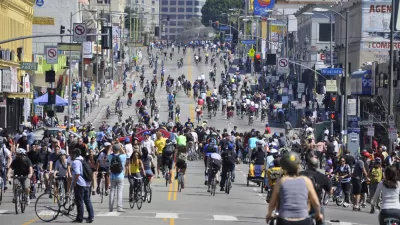Even in cities without world-class transit systems, transit can reduce car ownership to some extent.
The eminent journalist Stephen Dubner recently suggested that because many buses are under-utilized, the average bus is actually less fuel-efficient than the average car. His argument seems to be as follows: the typical bus burns more energy than the typical car- so much so that a bus with only ten passengers actually uses more energy per passenger than the average car. Thus, an underutilized bus is less fuel-efficient than a car.
But to the extent this argument is an argument for anti-transit policies, it may be a self-fulfilling prophecy. Here's why: suppose that a city, in reliance on this argument, adopts the panopoly of anti-transit policies common in the late 20th century- reducing transit service, building highways to places that don't have transit service, using low-density zoning to reduce the number of residences accessible by transit, etc. By making transit less attractive, these policies reduce bus* ridership. And the fewer riders a bus has, the less fuel-efficient it is, since a bus uses roughly the same amount of energy whether it has five riders or fifty.
Furthermore, even the mostly-empty bus has an indirect positive effect on fuel efficiency that a pure car/bus comparison doesn't catch. Often, transit riders aren't just transit riders; they are pedestrians as well. Unless my bus stops directly in front of my home and goes directly to my job, I am adding a zero-emissions walking trip to my commute- a trip over land that I would otherwise access by car. And if I walk to lunch or to other errands during the workday, I am adding other zero-emissions trips to my day- trips that, if I drove to work, might also be by car. Thus, a proper comparison is not just between an underused bus and a car, but between (underused bus + environmental impact of walking trips taken by bus riders) and the car. I admit, however, that I do not know whether the impact of these walking trips is significant enough to close the efficiency gap between underutilized buses and cars.
And where transit is significant enough to allow people to forego cars entirely, buses create an even more positive impact. For example, when I lived in Buffalo and Cleveland between 1996 and 1999, the transit system was just good enough to enable me to avoid owning a car. In addition to riding (often underutilized) buses and trains, I was also walking much more than I would have done had I owned a car, thus improving fuel efficiency much more than if I had only used buses and cars. By contrast, had these cities had a weaker transit system, I would have owned a car and used it to supplement not only transit trips, but also some of my walking trips.
The example of Buffalo suggests that, even in cities without world-class transit systems, transit can reduce car ownership to some extent. Buffalo has buses running until around 1 am (though often not very frequently at such hours) and a one-line light rail system extending to the city limits. By contrast, Jackson, Ms., has buses running until 7:45 pm and no trains. Even though Jackson is slightly poorer ** (and thus might be expected to have more people who cannot afford cars), only 11 percent of Jackson households make do without a car, as opposed to 31 percent of Buffalo households. The example of Buffalo shows that even a mediocre public transit system can affect car ownership, and thus reduce pollution.
*Or, for that matter, rail. However, Dubner suggests that rail is actually more fuel-efficient than buses, so in this post I focus on buses.
**Jackson's per capita income is just over $18,000, while Buffalo's is just over $20,000.

Alabama: Trump Terminates Settlements for Black Communities Harmed By Raw Sewage
Trump deemed the landmark civil rights agreement “illegal DEI and environmental justice policy.”

Study: Maui’s Plan to Convert Vacation Rentals to Long-Term Housing Could Cause Nearly $1 Billion Economic Loss
The plan would reduce visitor accommodation by 25% resulting in 1,900 jobs lost.

Planetizen Federal Action Tracker
A weekly monitor of how Trump’s orders and actions are impacting planners and planning in America.

Wind Energy on the Rise Despite Federal Policy Reversal
The Trump administration is revoking federal support for renewable energy, but demand for new projects continues unabated.

Passengers Flock to Caltrain After Electrification
The new electric trains are running faster and more reliably, leading to strong ridership growth on the Bay Area rail system.

Texas Churches Rally Behind ‘Yes in God’s Back Yard’ Legislation
Religious leaders want the state to reduce zoning regulations to streamline leasing church-owned land to housing developers.
Urban Design for Planners 1: Software Tools
This six-course series explores essential urban design concepts using open source software and equips planners with the tools they need to participate fully in the urban design process.
Planning for Universal Design
Learn the tools for implementing Universal Design in planning regulations.
Caltrans
Smith Gee Studio
Institute for Housing and Urban Development Studies (IHS)
City of Grandview
Harvard GSD Executive Education
Toledo-Lucas County Plan Commissions
Salt Lake City
NYU Wagner Graduate School of Public Service





























